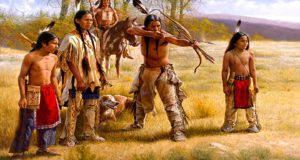
What Native Americans Can Teach Us About Sustainability
We know that the earth and all of creation came into being by God as designer and creator. God put in place a number of finely tuned systems, cycles and physical parameters that sustain life.
Adam and Eve were given instructions to care for and work the garden. Adam was a caretaker of creation, not a conqueror. Throughout the Bible we see God demonstrating to His people that the land belongs to Him, not us, and we are merely aliens here and His tenants (Leviticus 25:23). God instructed man not to overuse the land and to allow it to lie fallow every seven years. So, from many biblical examples, it is clear that God expected humans to sustainably manage the resources He provides. We are to leave an inheritance for our children’s children (Proverbs 13:22).
While Christians should in no way abandon the mandates given to us in the Bible, there is much to learn about caring for the land from those who don’t necessarily believe the same as we do — specifically the Native American people.
Native Americans
Europeans who arrived in America must have thought that the fertile, well-managed land just happened to be there. They knew that native people existed but did not give credit to their skills or knowledge. Because of this, they missed the opportunity to learn about a highly complex and sustainable form of earth management. In fact, this form of land management was one of the most sophisticated that has ever existed.
The lands that our forefathers first put their eyes on was not “untouched” or “wild” as some have recorded, but rather the result of a broad range of indigenous, land management techniques. Today, these techniques are being rediscovered amongst sustainable agriculture activists who are seeking to bring back to life that which has been buried by industrialization, commercialization and a general disrespect for the earth.
The hidden secrets of making herbal medicines…right at your fingertips!
It behooves all of us interested in living as sustainably as possible to delve deeper into the ways of the past. The ways that the Native American people managed to survive in some of the harshest climates in our country — places where winds blow, temperatures freeze or scorch and water is scarce.
What does it mean to be sustainable?
The term “sustainable” or “sustainability” has come to mean a number of things including:
- Renewing resources at a rate equal to or greater than the rate at which they are consumed.
- Living within the resources that are available without damaging the environment.
- A community that resembles a living system where all resources are renewed and in balance always.
- An economic system that provides a high quality of life while renewing the environment and its resources.
Although all of these definitions are somewhat different, they all hold something in common — a respect for the earth, for natural resources and a stewardship mindset.
 John Muir commented in the late 1800s that “Indians walk softly and hurt the landscape hardly more than birds or squirrels.” As a result, the land before the Europeans arrived was rich and fertile, organized and well-tended. Native Americans did not struggle against nature. They worked within the set boundaries and out of a spirit of respect. They took no more than they could use and used all they could from what they took, being sure to put the time and energy into the land so that it would continue to yield and continue to produce for generations to come.
John Muir commented in the late 1800s that “Indians walk softly and hurt the landscape hardly more than birds or squirrels.” As a result, the land before the Europeans arrived was rich and fertile, organized and well-tended. Native Americans did not struggle against nature. They worked within the set boundaries and out of a spirit of respect. They took no more than they could use and used all they could from what they took, being sure to put the time and energy into the land so that it would continue to yield and continue to produce for generations to come.
Native Americans practiced extensive and intensive land management for food, clothing, shelter and medicine that was guided by a number of ethics including moderation, reciprocity, restraint, celebration and gratitude. In fact, we refer to Native Americans as the “first ecologists” or “first environmentalists.”
Here are just a few of the practices that allowed Native Americans to thrive without harming the earth.
Farming
Native Americans had no plows or heavy machinery but contrary to what many think, this was a good thing. The lack of plows actually helped sustain soil fertility. Many tribes used sophisticated methods of permaculture to harvest the same plants year after year. Because of this, there was no need to create new cropland by burning — like we do today. “Keep it living” was their goal. Perennial cultivation demonstrated their value and respect for nature.
In 1779, a soldier sent by General George Washington reported that his unit had destroyed more than 200 acres of Iroquois corn and beans that was the “best I ever saw.” Clearly, the natives and their “three sisters” companion cropping technique was a testimony to their agricultural prowess that has been highly underestimated.
At one time it was estimated that the Iroquois could support up to three times as many people on one acre as compared to Europeans and their wheat crops. Clearly they were doing something right.
Foraging
Native Americans learned that the land provided a great many plants whose usefulness extended far beyond food. Roots, greens, berries and tree bark were all on the menu and revered for the potent medicinal qualities. Many of these same plants provided building materials for shelter, fuel, tools and clothing. Tribes were careful not to over pick and their nomadic nature allowed for regeneration of resources in many areas. When natives harvested bark, for example, they took what they needed without killing the tree. So, compare this to our tree harvesting techniques today — our conquer mindset is what causes us to chop an entire tree down for perhaps only a portion of that tree, leaving the rest to rot on the forest floor.
Fishing
Natives applied the same attitude of stewardship and caring to aquatic harvesting. They carefully tended and even cleaned salmon streams. When the stream changed course they transplanted salmon eggs to the new stream channel to continue the circle of life. Coastal tribes moved rocks around in configurations that would provide for the highest yield of clams while maintaining natural order. They also made fishing nets out of spears and hooks attached to hemp twine.
Hunting
Native Americans hunted a variety of game and used all parts of the animal. They used the animal for food, clothing, shelter, tools, bedding or decoration for example. Hunting tools made from natural resources included throwing sticks, bows made from wood and animal tendons and arrows, spears and harpoons made from stones. They made netting from hemp or grasses to trap small game. Native Americans living in the plains hunted Buffalo with bows, arrows and spears. They used the meat for food and the hides for clothing, moccasins, tepees and bedding. There was no waste.
Lesson for all of us
Out of His grace and goodness, God has put everything on this earth for our survival. Historically, the Native American people understood, in their own way, that nature was to be tended, to be carefully and lovingly maintained, to be respected and not dominated. That the natural resources on the earth would continue to produce year after year – to provide the things needed for survival when steps were light and hearts were right.
This is what it means to be sustainable.
Do you agree or disagree? Tell us in the section below:
 Off The Grid News Better Ideas For Off The Grid Living
Off The Grid News Better Ideas For Off The Grid Living



